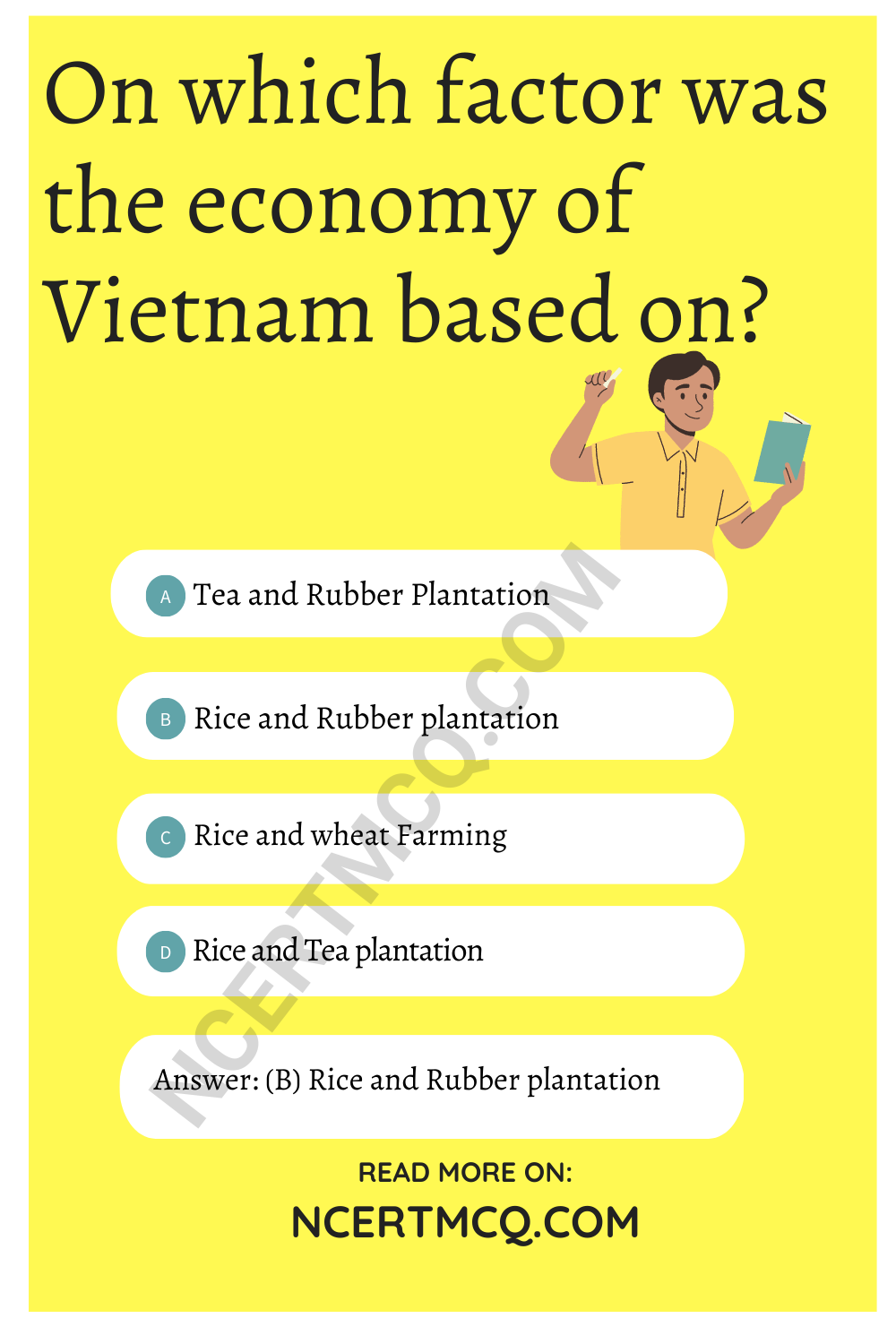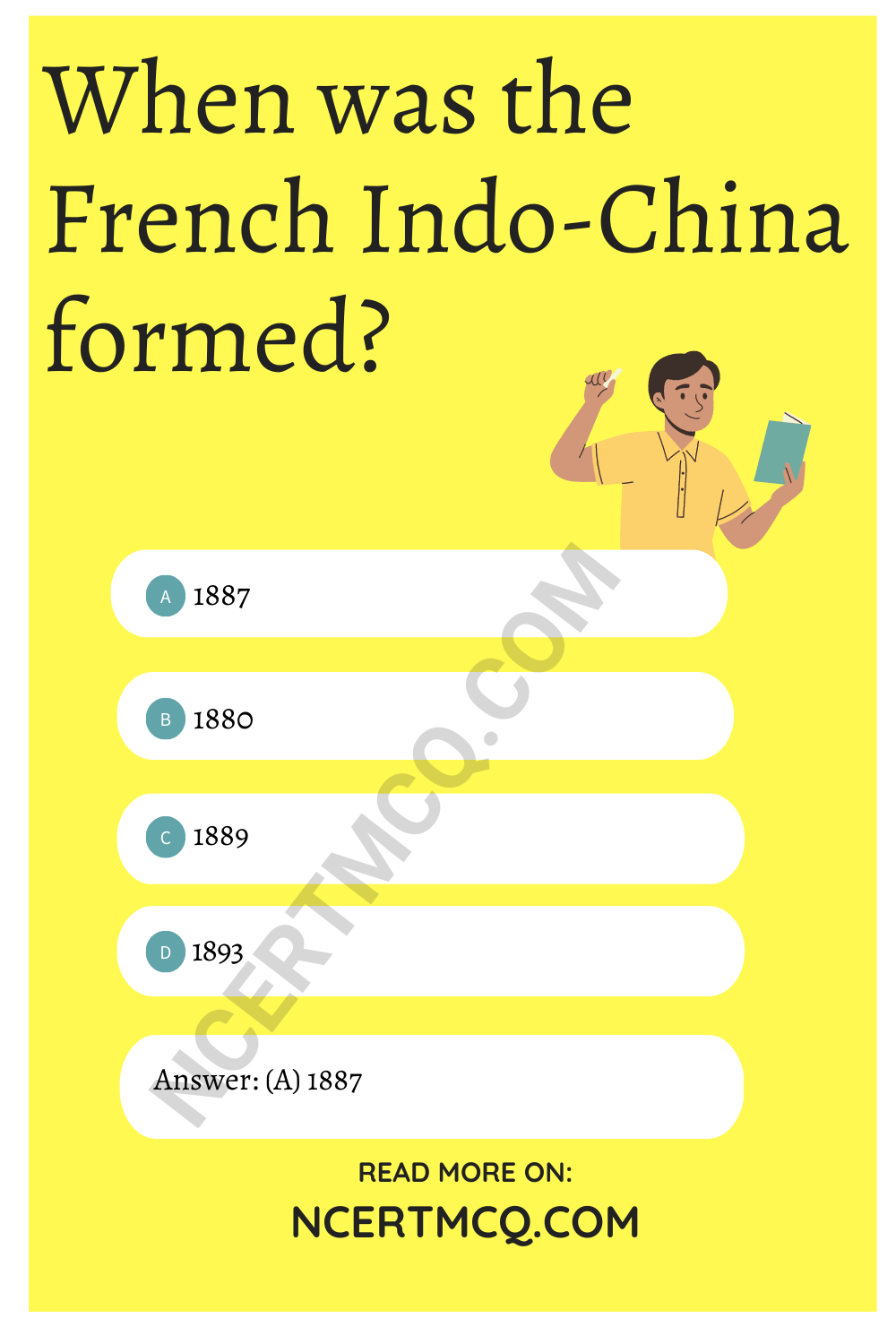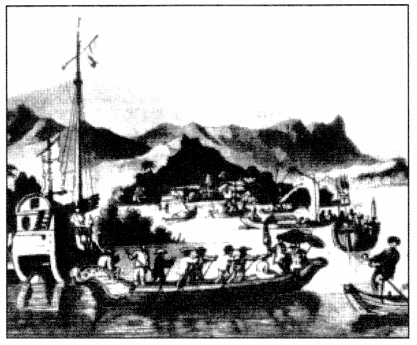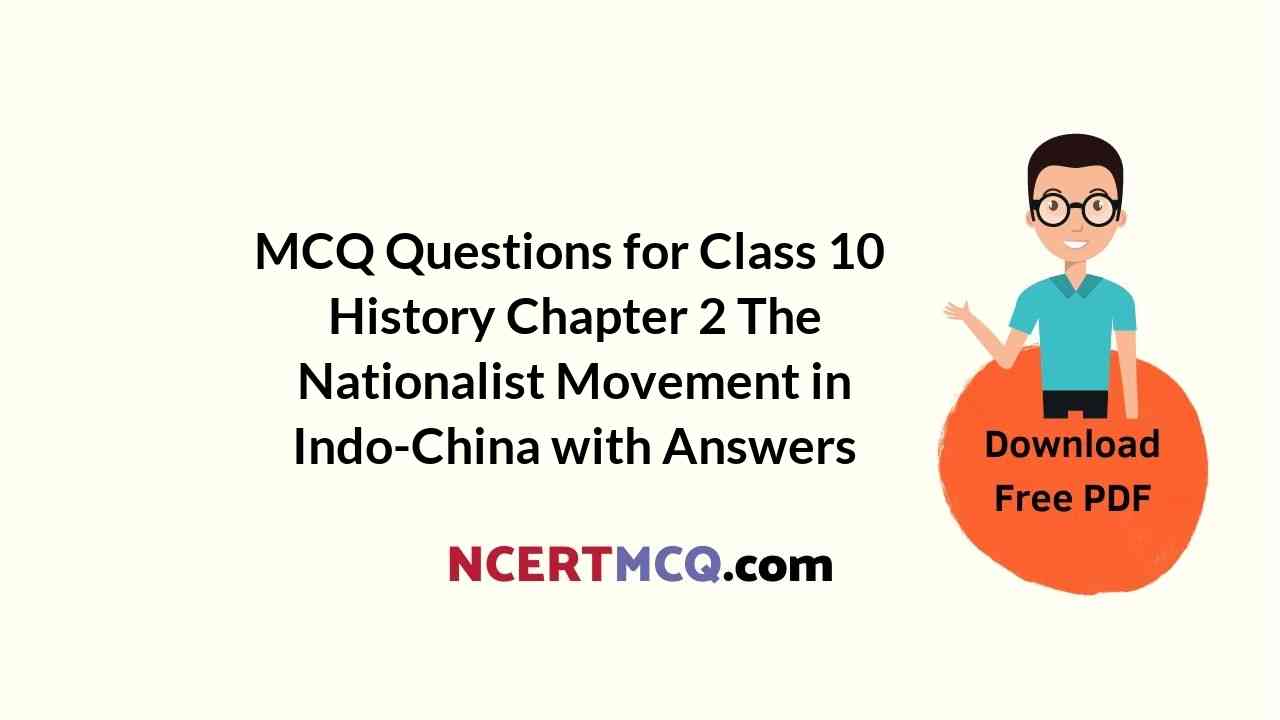Check the below NCERT MCQ Questions for Class 10 History Chapter 2 The Nationalist Movement in Indo-China with Answers Pdf free download. MCQ Questions for Class 10 Social Science with Answers were prepared based on the latest exam pattern. We have Provided The Nationalist Movement in Indo-China Class 10 History MCQs Questions with Answers to help students understand the concept very well. https://ncertmcq.com/mcq-questions-for-class-10-social-science-with-answers/
Class 10 Social Science History Chapter 2 MCQ With Answers
History Class 10 Chapter 2 MCQs On The Nationalist Movement in Indo-China
Choose the correct option:
MCQ Questions For Class 10 Icse History Chapter 2 Question 1.
The founder of the Hoa Hao movement is
(a) Phan Boi Chau
(b) Ho Chi Minh
(c) Huynh Phu So
(d) Phan Chu Jrinh
Answer
Answer: (c) Huynh Phu So
Class 10 History Chapter 2 MCQ With Answers Question 2.
Who, among the following, was a member of the French team, who explored Mekong river?
(a) Paul Bernard
(b) Liang Qichao
(c) Nuynh Phu So
(d) Francis Garnier
Answer
Answer: (d) Francis Garnier
Class 10 History Chapter 2 MCQ Question 3.
Who, among the following, was the head of the Revolutionary society formed by Phan Boi Chau?
(a) Prince Cuong De
(b) Phan Boi Chau
(c) Pha Chit Trinh
(d) Liang Qichao
Answer
Answer: (a) Prince Cuong De
History Chapter 2 Class 10 MCQ Question 4.
Who among the following, wrote the ‘History of the Loss of Vietnam’?
(a) Phan Boi Chau
(b) Liang Quichao When was French Indo-China established?
(c) Phan Chu Trinh
(d) Prince Cuong De
Answer
Answer: (a) Phan Boi Chau
MCQ Questions For Class 10 History Chapter 2 Question 5.
When was French indo – China established?
(a) 1947
(b) 1887
(c) 1888
(d) 1889
Answer
Answer: (b) 1887
The Nationalist Movement In Indo-China MCQ Questions Question 6.
On which factor was the economy of Vietnam based on?
(a) Tea and Rubber Plantation
(b) Rice and Rubber plantation
(c) Rice and wheat Farming
(d) Rice and Tea plantation
Answer
Answer: (b) Rice and Rubber plantation

History Class 10 Chapter 2 MCQ Question 7.
Who was the founder of the Vietnamese communist party?
(a) Fhan chu Trinh
(b) Huynh Phu so
(c) Ho chi Minh
(d) Phan Boi chau
Answer
Answer: (c) Ho chi Minh
Ch 2 History Class 10 MCQ Question 8.
A branch of the Restorations society was established in Tokyo by whom?
(a) By teachers
(b) By Industrialist
(c) By students
(d) None of the above
Answer
Answer: (c) By students
History Chapter 2 MCQ Class 10 Question 9.
Which movement started in against the spread of Christianity by the French.
(a) The Hoa Hao moment
(b) The Liberation movement
(c) The scholars Revolt
(d) Go east movement
Answer
Answer: (c) The scholars Revolt
Class 10 History Chapter 2 MCQ With Answers Pdf Question 10
Which of the following Vietnamese women organized a large army to resist the Chinese?
(a) Trieu Au
(b) Nguyen Thi xuan
(c) Trung sisters
(d) None of the above
Answer
Answer: (c) Trung sisters
Ncert Class 10 History Chapter 2 MCQ Question 11.
What was the changes came to the nature of anti-French Independence Movement in Vietnam?
(a) Total Independence in Vietnam with no French presence.
(b) Setting up a Republic like China in Vietnam
(c) Establishing a democratic republic
(d) Establishing a constitutional monarchy in Vietnam
Answer
Answer: (c) Establishing a democratic republic
Explanation:
After the fall of Chinese monarchy in 1911, the nature of anti-French Independence Movement in Vietnam changed to establishing a democratic republic and not a constitutional monarchy in Vietnam.
History Class 10 Ch 2 MCQ Question 12.
When did the ‘Go East Movement’ was started?
(a) 1907-08
(b) 1906-09
(c) 1903-05
(d) 1909-11
Answer
Answer: (a) 1907-08
Explanation:
Go East Movement’ was started by 300 Vietnamese students in 1907-08 in Japan.
Class 10th History Chapter 2 MCQ Question 13.
Who is the writer of “The History of the Loss of Vietnam”?
(a) Phan Boi Chau
(b) Huynh Phu So
(c) Hoa Hao
(d) Mad Monze
Answer
Answer: (a) Phan Boi Chau
Explanation:
Under Liang Qichao, a Chinese reformer influence Phan Boi Chau had wrote “The History of the Loss of Vietnam”
Cbse Class 10 History Chapter 2 MCQ Question 14.
Who founded the Hoa Hoa movement?
(a) Huynh Phu So
(b) Hoa Hao
(c) Mad Monze
(d) Phan Boi Chau
Answer
Answer: (a) Huynh Phu So
Explanation:
Hoa Hoa movement founded by Huynh Phu So, in 1939, in the fertile Mekong delta area.
Class 10 Chapter 2 History MCQ Question 15.
In which year the war between Vietnam and the US officially end?
(a) 1974
(b) 1980
(c) 1978
(d) 1975
Answer
Answer: (a) 1974
Explanation:
In January 1974, in Paris, a peace settlement was signed between both. This ended conflict with the US but fighting between the Saigon regime and the NLF continued.
Question 16.
In which year the major protest was erupted in the Saigon Native Girls School.
(a) 1920
(b) 1926
(c) 1987
(d) 1955
Answer
Answer: (b) 1926
Explanation:
In 1926 a major protest erupted in the Saigon Native Girls School as the expulsion of a Vietnamese girl from the school.
Question 17.
What were the provinces of Nghe An and Ha Tinh called in Vietnam?
(a) Electric current
(b) Electric circuit
(c) Electric fuses
(d) None of the above
Answer
Answer: (c) Electric fuses
Explanation:
In the provinces of Nghe An and Ha Tinh, provinces were among the poorest, had an old radical tradition, and have been called the ‘electrical fuses’ of Vietnam.
Question 18.
How was women shown in magazines and journals in the 1960s?
(a) As housewives
(b) As brave dedicated workers
(c) As illiterates
(d) none of these
Answer
Answer: (b) As brave dedicated workers
Explanation:
As brave dedicated, fighters, shooting down planes and also as selfless workers with rifle in one hand and a hammer in the other.
Question 19.
What is napalm?
(a) A chemical bomb
(b) An organic compound
(c) A phosphorous bomb
(d) An atomic bomb
Answer
Answer: (b) An organic compound
Explanation:
An organic compound, used to thicken gasoline, burns slowly and sticks to human body and continues to burn.
Question 20.
Under whom was the Democratic Republic of Vietnam formed?
(a) Ho Chi Minh
(b) The Nguyen king
(c) Bao Dai
(d) Ngo Dinh Diem
Answer
Answer: (a) Ho Chi Minh
Explanation:
The Vietminh fought the Japanese occupation, recaptured Hanoi in 1945, and a Democratic Republic was formed under Ho Chi Minh.
Question 21.
The modern part of Hanoi was struck by which disease?
(a) Cholera
(b) Malaria
(c) Bubonic Plague
(d) Typhoid
Answer
Answer: (c) Bubonic Plague
Explanation:
In 1903, the modern part of Hanoi was struck by the disease known as Bubonic Plague. In many colonial countries, measures to control the spread of disease created serious social conflicts.
Question 22.
Explain ordinance 10?
(a) A French law that permitted Christianity but outlawed Buddhism
(b) A Chinese law that permitted Confucianism but outlawed local practices.
(c) A Vietnamese law that permitted Buddhism but outlawed Christianity
(d) A Japanese law that permitted Buddhism but outlawed Hinduism.
Answer
Answer: (a) A French law that permitted Christianity but outlawed Buddhism
Explanation:
Ordinance 10, a French law that permitted Christianity but outlawed Buddhism. His dictatorial rule came to be opposed by a broad opposition united under the banner of the National Liberation Front.
Question 23.
Which one of the following parties was established by Ho Chi Minh in 1930?
(a) Vietnamese Communist Party
(b) The League for the Independence of Vietnam
(c) National Liberation Front
(d) None of these
Answer
Answer: (a) Vietnamese Communist Party
Explanation:
In February 1930, Ho Chi Minh brought together competing nationalist groups to establish the Vietnamese Communist (Vietnam Cong San Dang) Party, later renamed the Indo-Chinese Communist Party.
Question 24.
Which European country colonised Vietnam?
(a) France
(b) USA
(c) Germany
(d) England
Answer
Answer: (a) France
Explanation:
France was the European countries to bring the benefits of civilisation to backward peoples and colonised Vietnam.
Question 25.
When was the French Indo-China formed?
(a) 1887
(b) 1880
(c) 1889
(d) 1893
Answer
Answer: (a) 1887
Explanation:
After the Franco-Chinese war the French assumed control of Tonkin and Anaam and, in 1887, French Indo-China was formed.

Picture-based Questions:
Look at the following figure (NCERT TB Page 20) and answer the questions that follows.
(i) Identify the picture given below. Who founded it?
(ii) Write one sentence about it.

Answer
Answer:
(i) The Port of Faifo. This port was founded by the Portuguese merchants.
(ii) It was one of the ports used by European trading companies much before the nineteenth century.
Source-based Questions:
Read the following passage (Source B NCERT TB Page 43) and answer the questions that follow:
Declaration of independence
The declaration of the new republic began by reaffirming the principles of the declaration of independence of the United States in 1771 and of the French Revolution in 1791 but added that the French imperialists do not follow these principles for they ‘have violated our fatherland and oppressed our fellow citizens. They have acted contrary to the ideals of humanity and justice.
‘In the field of politics, they have deprived us of all liberties. They have imposed upon us inhuman laws … They have built more prisons than schools. They have mercilessly slain our patriots; they have drowned our uprisings in rivers of blood. ‘They have fettered public opinion; they have practiced obscurantism against our people … ‘For these reasons, we members of the Provisional Government, representing the entire population of Vietnam, declare that we shall henceforth have no connection with imperialist France; that we abolish all the privileges which the French have arrogated to themselves on our territory …
‘We solemnly proclaim to the entire world: Vietnam has the right to be free and independent, and in fact has become free and independent.’
Questions:
(i) How did the French exploit the Vietnamese?
(ii) Which values are associated with the declaration of independence of the USA in 1776 and of the French Revolution in 1791?
Answer
Answer:
(i) The French exploited the Vietnamese in a number of ways-
- They deprived them of all liberties.
- They imposed upon them inhuman laws.
- They distorted their culture and traditions.
- They mercilessly killed Vietnamese nationalists and patriots.
- They suppressed the uprisings iron-handed.
(ii) The values associated with the declaration of independence of the USA and of the French Revolution are-
- Freedom to express independent opinion
- Right to live in a humane environment
- Right to be free and independent
- Humanity and justice.
We hope the given NCERT MCQ Questions for Class 10 History Chapter 2 The Nationalist Movement in Indo-China with Answers Pdf free download will help you. If you have any queries regarding The Nationalist Movement in Indo-China CBSE Class 10 History MCQs Multiple Choice Questions with Answers, drop a comment below and we will get back to you soon.
Class 10 Social Science History MCQ:
- The Rise of Nationalism in Europe Class 10 MCQ
- The Nationalist Movement in Indo-China Class 10 MCQ
- Nationalism in India Class 10 MCQ
- The Making of Global World Class 10 MCQ
- The Age of Industrialisation Class 10 MCQ
- Work, Life and Leisure Class 10 MCQ
- Print Culture and the Modern World Class 10 MCQ
- Novels, Society and History Class 10 MCQ
